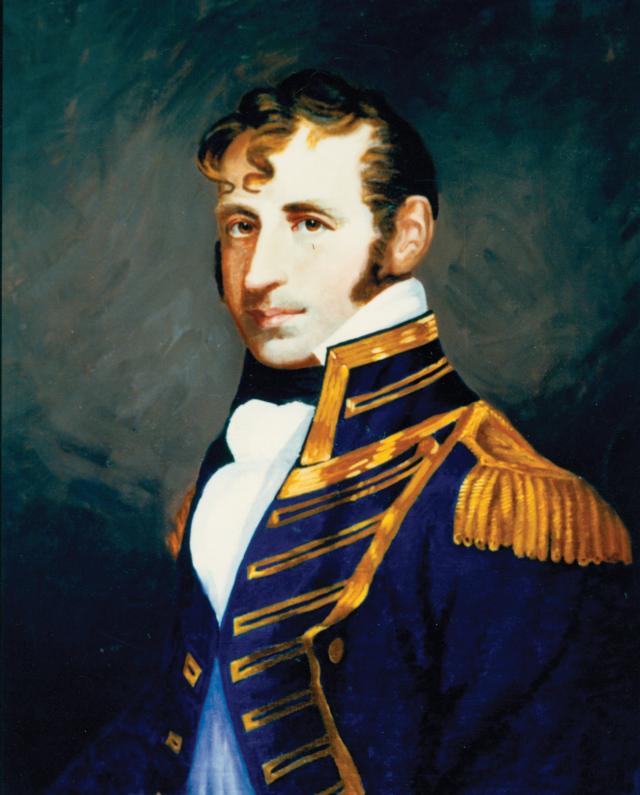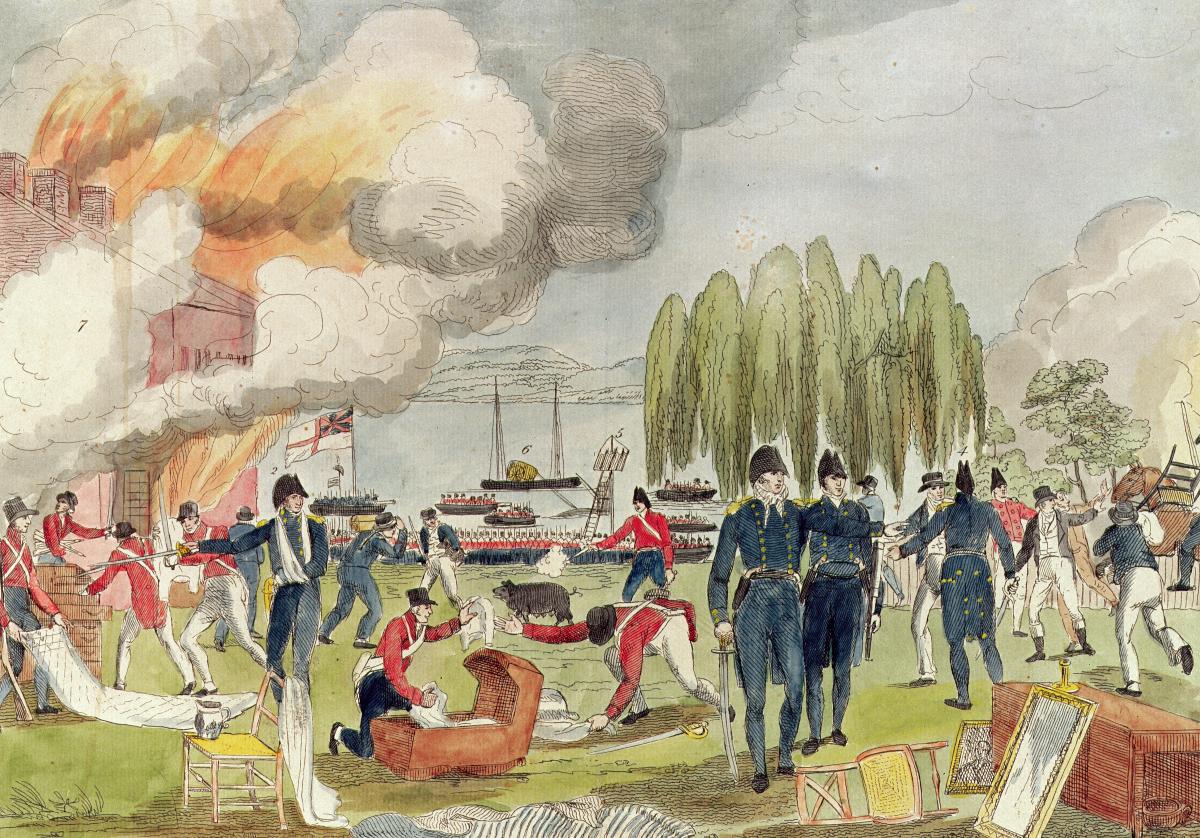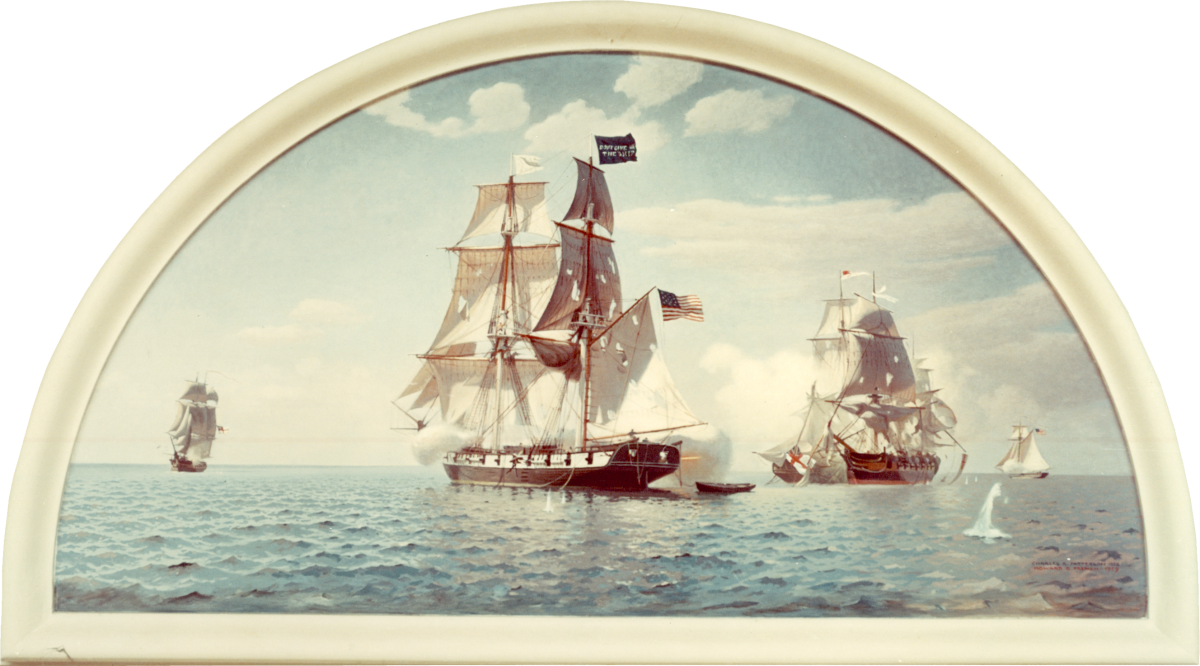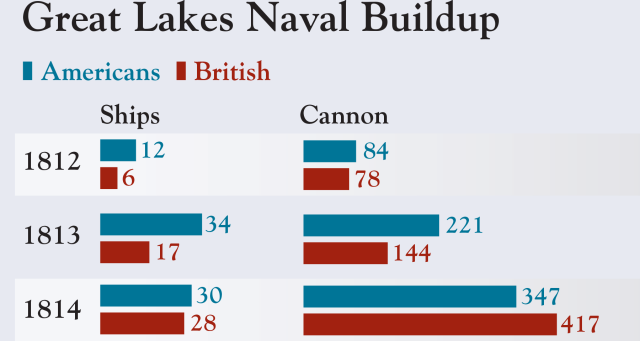The War of 1812 was a conflict between two very different naval powers, a pattern that is far more common in naval history than tends to be appreciated. Aside from a fundamental contrast in their strength—Britain had the world's leading navy while the United States lacked a battle fleet—the opposing sides used their navies for very different purposes. Because no large-scale naval clashes unfolded on the high seas, it is all too easy to underrate the crucial strategic dimensions of naval power and its importance for the character and development of the war.
The United States had maritime, rather than naval, strength. The American merchant marine had grown rapidly in size and importance after the Revolutionary War, and its range had greatly increased. However, there was no comparable expansion in American naval power because the new country did not seek command of the sea nor transoceanic commercial or political dominion. Indeed, the last American warship was sold in 1785.
The American Navy, however, was revived in the mid-1790s, albeit as a minor force. In 1794 Congress approved the construction of six frigates to fight against the privateering Barbary State of Algeria. The last of the six was launched during the 1798-1800 Quasi-War, which was the result of French maritime pressure on American trade. By 1812, the U.S. Navy had experience, but it was on a totally different scale to the Royal Navy. The Americans had an abundance of trained seamen to man their Fleet and the most powerful frigates of the age, which they were to prove adept at handling in ship-to-ship actions, but they had no ships-of-the-line, unlike Britain, which dominated in this sphere. The U.S. Navy at the outset of the War of 1812 comprised only 16 ships, nine of them frigates. The Americans thus lacked the capacity for fleet action.
This reflected the force structure and naval doctrine developed under President Thomas Jefferson's agrarian republicanism.1 In part, concerns about the cost and likely effectiveness of a large fleet had encouraged opposition within the United States to its creation, while the Jefferson administration's emphasis on gunboats conformed to a militia tradition.
Early American Naval Triumphs
Initially, the United States planned a quick land offensive against Lower Canada up the Champlain Valley, which led to only limited interest in a strategic role for the Navy. At the outbreak of the war, however, the Americans found it easier to act at sea than to strike on land, where there were problems with mobilization.2 The need to protect trade was also a key issue, and concern about safeguarding incoming merchantmen helped ensure a shift in attitude. As a result, ships were to be sent to sea, not only to convoy merchantmen but also to destroy the British warships that might attack them.
A naval emphasis also accorded with the politics of Americans who saw the purpose of the war not as conquering Canada, but as pressuring Britain to end hostile commercial policies. The seizure of territory in Canada was also intended to further this objective, although, conversely, naval action was seen as a possible way to put pressure on the British in Canada. Indeed, there was a common naval focus because Canada was perceived as a key source of the naval resources, especially timber, needed by the British Navy. Moreover, President James Madison was convinced that Napoleon would succeed in limiting British access to its other major source of naval stores, the Baltic, which would focus greater attention on Canada.3
Commodore John Rodgers, the U.S. Navy's senior officer, saw opportunities in taking the initiative, and in accordance with his proposal, the American warships at New York were sent to sea in two squadrons in 1812. The three frigates and two smaller vessels under Rodgers searched for a British convoy homeward bound from the West Indies, which he saw as a source of wealth for himself and the country. He failed to find his convoy, but after the squadrons had been dispersed, the U.S. frigates were more successful on their own. The British frigates Guerrière and Java fell victim to the Constitution, and a third Royal Navy frigate, the Macedonian, to the USS United States. With 24-pounder cannon, the American ships were more heavily gunned than the British vessels with their 18-pounders.
These successes provided an initially valuable boost to American morale. Congress awarded Captain Isaac Hull of the well-gunned Constitution a gold medal for his capture of the Guerrière on 19 August, although the collisions between the two ships showed that his seamanship was not what it should be. After the same ship captured the Java on 29 December, Captain William Bainbridge, who had replaced Hull in command, also received a Congressional Gold Medal.
Indeed, the Americans initially did better at sea than anticipated. The victories also helped cover the return of American merchantmen, whose cargoes and customs revenues contributed to financing the war. Conversely, the United States did worse on land, which made the naval triumphs particularly worthwhile. Speaker of the House of Representatives Henry Clay, however, grumbled, "Brilliant as they are . . . they do not fill up the void created by our misfortunes on land."4
Reasons for the British Defeats
At sea, the British initially suffered from overconfidence; inaccurate gunnery, which reflected poor gun drill; and ships that were simply less powerful and less well prepared than those of their opponent. Fire from the Constitution's double-shotted guns, for example, demasted the Guerrière and repeatedly pierced her hull. In addition, the Royal Navy's North American station was not key in the ongoing war with Napoleon and, as a result, had been starved of resources. Indeed, many of the British ships were in poor condition as well as short of sailors; the latter was a continual problem for the Royal Navy that had helped lead to war. Moreover, the dockyards in Halifax and Bermuda lacked sufficient materiel and skilled shipwrights to ensure that the fleet remained seaworthy, and ships requiring major repairs had to be sent back to British dockyards.5 This was the underside of being the world's leading naval power.
In contrast, the Americans could call on effective local dockyards, while better gunners and heavier guns greatly helped their warships, as with the United States' capture of the Macedonian on 25 October 1812. Aside from the three frigates, the other British losses in 1812 were all of smaller vessels, such as the sloop Alert, carrying 20 guns, captured by the Essex, with 46, on 13 August. In this clash, the British guns were 18-pounder carronades, while all but six of the American guns were 32-pounder carronades. On 18 October, the sloop Wasp captured the British sloop Frolic, but was then quickly taken by the 74-gun HMS Poictiers.
The American successes in the 1812 frigate clashes caused a furor in Britain, with much public soul-searching about fighting quality. On 18 February 1813, George Canning, a former treasurer of the navy and foreign secretary, told the House of Commons that "the sacred spell of the invincibility of the British Navy was broken."6 John Croker, the influential secretary to the Admiralty, thought it necessary to publish the "Letter on the Subject of the Naval War with America" in defense of the government. In response to a sense of crisis, the Admiralty both built up its Halifax-based squadron and issued an order that it had not felt obliged to promulgate in the case of the conflict with the French. On 10 July 1813, Croker informed station commanders-in-chief that the Admiralty did not conceive that any of His Majesty's frigates should attempt to engage, single handed, the large class of American ships; which though they may be called frigates, are of a size, complement and weight of metal much beyond that class, and more resembling line of battle ships. In the event of one of His Majesty's frigates under your orders falling in with one of these ships, her captain should endeavour, in the first instance, to secure the retreat of His Majesty's ship, but if he finds that he has advantage in sailing, he should endeavour to manoeuvre, and keep company with her, without coming to action, in the hope of falling in with some other of His Majesty's ships with whose assistance the enemy might be attacked with a reasonable hope of success.7
A sense of the enormity of the British task led Admiral Sir John Borlase Warren, the head of the North American Station, to press for reinforcements. His argument, in January 1813, was that these were needed "in consequence of the enemy's privateers becoming daily more numerous and the assembling of a force of three thousand men at Eastport [in present-day Maine] on the frontiers of New Brunswick and menacing that province with attacks."8
Nevertheless, aside from the fact that there would be no invasion of New Brunswick, America would exert no serious pressure on British naval strength. The United States built ships-of-the-line during the war, but they were not ready in numbers for battle, which was just as well in light of the Royal Navy's numerical superiority. The Independence, a 74-gun ship, was launched at Charlestown, Massachusetts, in June 1814, while, four months later, the Washington, another 74-gunner, was completed at Portsmouth. Construction of the latter had begun in the spring of 1813, which showed how long it took to build up naval strength.
Overall economic capability and institutional experience gave the British a considerable advantage at sea. By 1812, the victualling system of the British Navy was feeding 145,000 men daily (aside from prisoners), and it was possible to mount a formidable effort in North America.
Yet most of the Royal Navy, including its best commanders, was involved in operations against France. For example, Captain William Hoste, a protege of Vice Admiral Horatio Lord Nelson's and a master of frigate operations, held the Adriatic in awe in 1812-14. Napoleon had rebuilt his fleet after its heavy defeat at Trafalgar in 1805, and the British had to devote much effort to blockading French ports and supporting land operations in Europe, especially in Iberia. There was great concern about the Toulon-based French fleet. The Royal Navy was stretched in the Mediterranean, and there was particular anxiety about enemy sorties from Toulon in 1811 and 1812. British naval resources were also strained elsewhere.9 Nevertheless, the capture of French overseas bases lessened the ability of Napoleon's navy to challenge the British, and thus made it possible to build up strength in American waters. Moreover, funding for the Royal Navy rose, reaching a peak of £20.1 million in 1813.10
Denying Access to the Sea
American successes in individual clashes did not prevent the implementation of a British blockade of most of the United States that transformed the naval situation by lessening American options. Indeed, Croker wrote to Warren in January 1813 that the Admiralty had withdrawn ships from other stations to place "under your orders a force with which you cannot fail to bring the naval war to a termination, either by the capture of the American national vessels, or by strictly blockading them in their own waters." 11
Blockade was seen as the way to deal with American privateering—government-sanctioned attacks on British merchantmen by privately owned vessels—as well as trade. In March 1813, Warren was ordered to blockade New York City, Charleston, Port Royal, Savannah, and New Orleans. Robert, 2nd Viscount Melville, who had become the First Lord of the Admiralty in June 1812, wrote him that,
"We do not intend this as a mere paper blockade, but as a complete stop to all trade and intercourse by sea with those ports, as far as the wind and weather, and the continual presence of a sufficient armed force, will permit and ensure. If you find that this cannot be done without abandoning for a time the interruption which you appear to be giving to the internal navigation of the Chesapeake, the latter object must be given up, and you must be content with blockading its entrance and sending in occasionally your cruisers for the purpose of harassing and annoyance."12
Thus, blockade was seen as more important than raiding the Chesapeake Bay, an instructive indication of the importance of economic warfare and one that is important to bear in mind when considering British operations. In fact, the blockade greatly harmed the U.S. economy, with exports dropping from $45 million in 1811 to $7 million in 1814, and it became more effective from 1813, restricting American raids as well as trade.13 Studies tend to devote insufficient attention to the blockade, which drew together the military, political, and economic dimensions of the war. In some respects, it was the counterpart to the policy of essentially resting on the defensive recommended for Canada in 1812-13, although it had far more capacity to bite.
Maintaining the blockade, however, was far from easy. Admiral Warren noted in December 1813 that British efforts at the mouth of the Chesapeake were not fully effective: "Several large Clipper Schooners of from two to three hundred Tons, strongly manned and armed have run thro' the Blockade in the Chesapeak, in spite of every endeavour and of the most vigilant attention of our Ships to prevent their getting out, nor can any thing stop these Vessels escaping to Sea in dark Nights and Strong Winds."14
The English newspaper Trewman's Exeter Flying-Post reported on 1 December 1814, "Letters received from the American coast . . . state that the Constitution and Guerrière frigates had been victualled for twelve months, and were waiting for an opportunity to slip out to sea—which it was expected a dark night whilst our ships were blown from the coast by the gales, would present to them." In January 1815, the 18-gun sloops USS Hornet and Peacock were able to evade the British blockade of New York City en route for the South Atlantic, although the frigate President surrendered after failing to breach the New York blockade, and the Constellation, also a frigate, could not break through the Chesapeake blockade. As a result, the attempt to operate the U.S. warships in squadron strength failed. A squadron might have been powerful enough to overcome a British convoy.
If, by strengthening their blockade, the British lessened the inroads of American privateers and warships, the Americans nevertheless thought it worthwhile to push ahead with naval construction. This reflected both a political and public conviction, drawing on the euphoria arising from victories, that naval power was worthwhile and a more specific awareness that it had indeed brought advantages.
Rising and Declining Naval Success
British gunnery improved during the war as, more generally, did Royal Navy effectiveness in Atlantic waters and on the Great Lakes. This can be seen in the fate of American warships and commanders. Stephen Decatur, already a hero for seizing and burning the captured Philadelphia in Tripoli Harbor in 1804, captured the frigate Macedonian off the Azores when he commanded the United States. Yet his reputation was compromised when he surrendered the President.15
The 44-gun frigate slipped out of New York on the night of 14 January 1815 but sustained severe damage when her pilot ran her aground on the Sandy Hook bar. Chased by blockaders the next day, the President shot the sails from the yards of a 42-gun pursuer. When two lesser frigates closed in, one of which poured two broadsides into the President, Decatur surrendered. The two British ships were mainly armed with 18-pounders, versus the American frigate's 24- and 42-pounders, and in Theodore Roosevelt's estimation, the famous American commander "acted rather tamely, certainly not heroically" in not fighting it out with them. "At least it was well worth trying."16
Larger British naval forces were also effective against individual ships farther afield. In the frigate Essex, Captain David Porter had successfully attacked British commerce in the South Atlantic and the South Pacific, capturing 12 whalers and their valuable cargo off the Galapagos Islands in 1813. This was part of a major extension in American trade warfare, but two British warships forced Porter to surrender off Valparaiso, Chile, on 28 March 1814 after they cannonaded his disabled ship from a distance. Six months later, the British suffered far more casualties than the Americans when they attacked the privateer General Armstrong in the Azores' Faial Harbor, but the Americans eventually scuttled and burned the ship.
In addition, the British were often successful in conflicts between individual ships. On 1 June 1813, HMS Shannon beat the Chesapeake off Boston in a bloody clash fought at close range in which a lack of preparedness on the part of the American commander was a key factor.17 On 14 August 1813, the USS Argus was captured off Wales by the similarly gunned Pelican after the British gunners proved superior.18 The next year, the British frigate Le Rhin captured the largest privateer to sail from Charleston, the Decatur, which had boarded and seized the British sloop Dominica in August 1813.
American privateers and small warships nevertheless had an overall impact on Great Britain's merchant marine. British trade was higher in 1814 than in 1811; however, the country's traders necessarily faced the risk of attack from American privateers. This affected the practice and profitability of trade.19 According to Lloyd's, the British lost 1,175 merchantmen during the war of which only 373 were recaptured, and although overall insurance rates remained steady, they rose in some particular trades.20 This showed that even a modest American fleet had been "able to enforce high protection costs on Britain."21
British privateering meanwhile made major inroads on American trade, as well as bringing prosperity to the British possessions of Nova Scotia, New Brunswick, and Bermuda, where the raiders were based. These privateers faced fewer obstacles from American warships than their counterparts did from the British fleet, which was a measure of the success of the Royal Navy and its blockade.22 The navy could also provide the convoy protection necessary to send reinforcements to Canada.23 Had it been necessary, the service could have provided direct assistance to Quebec (while the St. Lawrence was free from ice) or Halifax, and without capturing those positions, Canada could not be taken.
Shore Raids and Amphibious Operations
As well as privateers, blockaders, and high-seas warships, the United States had to contend with British amphibious operations. In September 1812, William Duane, the editor of the Jeffersonian Philadelphia newspaper Aurora who was to be made an adjutant general, informed President Madison about his concern that the British would land a force between New York City and New Hampshire or destroy the former by bombardment.24 Indeed the defense problems of New England were linked to opposition there to the war.25
Since the start of the conflict the British launched raids on the American coast. The damage they inflicted in part testified to a willingness to make civilians suffer.26 Four days after the Americans turned back a June 1813 amphibious assault off Norfolk, at Craney Island, the British captured, pillaged, and burned nearby Hampton, Virginia. (The British Army officer in charge blamed the excesses on his command's two "Independent Companies of Foreigners," composed of French prisoners of war who chose to fight for their captors.27) Some British commanders, however, took measures to limit civilian suffering. For instance, Commodore Sir Thomas Hardy went out of his way to avoid noncombatant casualties when four warships under his command staged a four-day bombardment of tiny Stonington, Connecticut, in August 1814.28
The Americans had no control over whether raids could escalate into large-scale amphibious attacks, to which they were vulnerable. In 1812 America's ports lacked adequately integrated defenses, and there was also a widespread absence of planning for such attacks.29 American concern about amphibious assaults led, in July 1813, to the creation of a Corps of Sea Fencibles for the "defense of ports and harbors of the United States." Two companies of Baltimore fencibles helped defend Fort McHenry against the British in 1814.
Naval strength on coastal and inland waterways, moreover, allowed the British to safely land large numbers of troops. Such was the case in August 1814 when some 4,000 regulars came ashore 25 miles up Maryland's Patapsco River, routed a ragtag American force at Bladensburg, and burned Washington, D.C. About four months later, an even larger British force landed at Bayou Bienvenu, Louisiana, but its advance on New Orleans ended in a debacle.
British amphibious capability was retained to the end. On 11 February 1815, Vice Admiral Sir Alexander Cochrane captured Fort Bowyer, which protected Mobile. When hostilities ceased with news of the 24 December 1814 signing of the Treaty of Ghent, the capture of first Savannah and then Charleston had been planned, and both were already blockaded.30 Indeed, a report from HMS Ceylon off Georgia indicated that Admiral Sir George Cockburn was threatening to attack New York City.31
In contrast to British successes in American waters, the U.S. plan in May 1813 and May 1814 for a small squadron to cruise off Nova Scotia and the St. Lawrence to intercept British supply ships failed, in large part due to the British blockade of American ports. Alongside the key factor of the unpopularity of the war in New England, naval weakness also ensured that the Americans could not mount amphibious attacks on maritime Canada.
The War at Sea's Repercussions and Meanings
The War of 1812 was not a success for the United States as a naval power, but it was a triumph for its naval reputation. The ability to win duels at sea in 1812 created a lasting impression and helped make the U.S. Navy more popular than the Army. The Navy had been more successful in this light than in the War of Independence. Moreover, in 1816 Congress agreed to finance a plan for nine new ships-of-the-line and 12 large frigates; four and two, respectively, had been launched by 1826.
On the other hand, emphasizing the popularity the U.S. Navy gained during the war detracts from the realist perspective that, on the high seas, American power after 1815 remained dependent on British acceptance. In 1810 Britain had 152 ships-of-the-line and 183 frigates. The loss of several frigates to the U.S. Navy was humiliating. Indeed, the British responded to their shame by exaggerating the strength of the American warships and underplaying those of the British ships.
The loss of the frigates, however, was no real qualification of British maritime power. The War of 1812 was no triumph for Britain's naval reputation, but it underlined the extent of Britain's broad naval power and indicated what that offered in terms of blockade and amphibious capability.
The War on the Lakes
During the War of 1812, the United States displayed an important ability to develop naval capability on the Great Lakes. On 6 February 1813, President James Madison instructed the American commander of the northeast theater, Major General Henry Dearborn, on the need to outbuild the British on the Lakes: "If they build two ships, we should build four. If they build thirty or 40 gun ships, we should build them of 50 or 60 guns. The command of those waters is the hinge on which the war will essentially turn according to the probable course of it."1
The previous year, Captain Isaac Chauncey, former commandant of the New York Navy Yard, had built up a force that established a powerful presence on Lake Ontario, while in 1813, Master Commandant Oliver Hazard Perry built nine ships, reversing the situation on Lake Erie. In 1814, however, the British recovered their position above the Detroit River on Lake Huron, using small boats.2 They were also able to construct the St. Lawrence, a 104-gun three-decker, at Kingston on Lake Ontario,while about 25 miles away at Sackets Harbor, New York, the Americans worked on a ship-of-the-line, the New Orleans.3
The benefit gained from an increased naval presence on the Great Lakes, however, must be set against the formidable logistical challenge posed by the requirements of building up the naval forces. These demands limited the prospects for land operations at the same time that success on the Great Lakes made them a more likely prospect; defeated opponents were forced to rely on the slower prospect of movement by land, while the victors could move troops over water.
The latter advantage was such that the Duke of Wellington, who had experience with combined operations and had benefited from British command of the sea, advised Liverpool in November 1814 that without dominating the Lakes "it is impossible . . . to keep the enemy out of the whole frontier [with Canada], much less to make conquest."4 He added the following month, "I have told the Ministers repeatedly that a naval superiority on the lakes is a sine qua non of success in war on the frontier of Canada, even if our object should be solely defensive."5
Alfred Thayer Mahan, the great theorist of naval warfare who was a key advocate of American deep-sea naval power later in the century, argued that "the victories on Lake Erie and Lake Champlain do illustrate, in a distinguished manner . . . the controlling influence upon events of naval power, even when transferred to an inland body of fresh water."6 At the same time, such superiority, while important around the Lakes, did not provide more than an advantage farther afield. More generally, the American 1813 campaigns around the Lakes also indicated the problems of sustaining and exploiting advantages.
That year, Perry's victory at the Battle of Lake Erie cleared the way for Major General William Henry Harrison's invasion of Upper Canada and defeat of British Major General Henry Procter's British-Indian force. On Lake Ontario, meanwhile, the Americans mounted an amphibious operation that led to the capture of Fort George. Nevertheless, the successes came to naught. Harrison's army withdrew and was broken up, and at the end of 1813, the British captured Fort Niagara, across the Niagara River from Fort George.
Jeremy Black
1. John B. Hattendorf, "The American Navy in the World of Franklin and Jefferson, 1775-1826," War and Society, (1990); Spencer Tucker, The Jeffersonian Gunboat Navy (Columbia, SC: University of South Carolina Press, 1993); Gene A. Smith, "For the Purposes of Defense": The Politics of the Jeffersonian Gunboat Program (Newark, DE: University of Delaware Press, 1995).
2. Peter J. Kastor, "Toward 'the Maritime War Only': The Question of Naval Mobilization, 1811-1812," Journal of Military History, 61 (1997), pp. 455-80.
3. John C. A. Stagg, "James Madison and the Coercion of Great Britain: Canada, the West Indies, and the War of 1812," William and Mary Quarterly, 3rd ser., 38 (1981), pp. 32-4.
4. The Papers of Henry Clay, ed. James F. Hopkins, vol. 1, Rising Statesman, 1797-1814 (Lexington, KY: University of Kentucky Press, 1959), p. 751.
5. Barry J. Lohnes, "British Naval Problems at Halifax during the War of 1812," Mariner's Mirror, 59 (1973), pp. 317-33.
6. Hansard's Parliamentary Debates, vol. 24, p. 643.
7. William S. Dudley (ed.), The Naval War of 1812: A Documentary History, vol. II (Washington, DC: Naval Historical Center, 1992), p. 183.
8. Ibid., p. 11.
9. David Syrett, "The Role of the Royal Navy in the Napoleonic Wars after Trafalgar, 1805-1814," Naval War College Review (1977), pp. 71-84.
10. William Laird Clowes, The Royal Navy: A History from the Earliest Times to the Present, Vol. V (London: Sampson Low, Marston & Co, 1900), p. 9.
11. Dudley, Naval War of 1812, Vol. II, p. 14.
12. Ibid., p. 78.
13. Joseph A. Goldenberg, "The Royal Navy's Blockade in New England Waters, 1812-1815," International History Review, 6 (1984), pp. 424-39.
14. Dudley, Naval War of 1812, Vol. II, p. 308.
15. Robert J. Allison, Stephen Decatur: American Naval Hero, 1779-1820 (Amherst, MA: University of Massachusetts Press, 2005).
16. Theodore Roosevelt, The Naval War of 1812 (New York: G. P. Putnam's Sons, 1882; Annapolis, MD: Naval Institute Press, 1987), pp. 358-64.
17. H. F. Pullen, The Shannon and the Chesapeake (Toronto: McClelland & Stewart, 1970).
18. Ira Dye, The Fatal Cruise of the "Argus": Two Captains in the War of 1812 (Annapolis, MD: Naval Institute Press, 2001).
19. John M. Sherwig, Guineas and Gunpowder: British Foreign Aid in the Wars with France, 1793-1815 (Cambridge, MA: Havard University Press, 1969); Gordon K. Harrington, "The American Naval Challenge to the English East India Company during the War of 1812," in Jack Sweetman (ed.), New Interpretations in Naval History (Annapolis, MD: Naval Institute Press, 1993), pp. 129-52.
20. N.A.M. Rodger, The Command of the Ocean: A Naval History of Britain, 1649-1815 (London: W. W. Norton & Company, 2004), pp. 569-70.
21. Jan Glete, Navies and Nations: Warships, Navies and State Building in Europe and America, 1500-1860 (Stockholm, 1993), p. 395.
22. Faye Margaret Kert, Prize and Prejudice: Privateering and Naval Prize in Atlantic Canada in the War of 1812 (St Johns, Newfoundland: International Maritime Economic History Association, 1997); Antohoy Gutridge, "George Redmond Hulbert: Prize Agent at Halifax, Nova Scotia, 1812-14," Mariner's Mirror, 87 (2001), pp. 30-42.
23. Faye Margaret Kert, "The Fortunes of War: Commercial Warfare and Maritime Risk in the War of 1812," Northern Mariner, 8 (Oct. 1998), pp. 1-16.
24. The Papers of James Madison, Presidential Series, eds. J.C.A. Stagg, Martha J. King, Ellen J. Barber, etc., vol. 5, 10 July 1812 - 7 February 1813 (Charlottesville, VA: University of Virginia Press, 2004339-41.
25. Donald Hickey, "New England's Defense Problem and the Genesis of the Hartford Convention," New England Quarterly, 50 (1977), pp. 587-604.
26. C. J. Bartlett, "Gentlemen versus Democrats: Cultural Prejudice and Military Strategy in Britain in the War of 1812," War in History, 1 (1994), pp. 140-59.
27. Dudley, The Naval War of 1812, Vol. II, pp. 364-65.
28. James Tertius de Kay, The Battle of Stonington: Torpedoes, Submarines, and Rockets in the War of 1812 (Annapolis, MD: Naval Institute Press, 1990).
29. Theodore J. Crackel, "The Battle of Queenston Heights, 13 October 1812," in Charles E. Heller and William A. Stofft (eds), America's First Battles, 1776-1965 (Lawrence, KS: University Press of Kansas, 1986), p. 33.
30. Roger Morriss, Cockburn and the British Navy in Transition: Admiral Sir George Cockburn, 1772-1853 (Exeter, England: University of Exeter Press, 1997), pp. 83-120.
31. Trewman's Exeter Flying-Post, 2 March 1815.
2. Barry M. Gough, Fighting Sail on Lake Huron and Georgian Bay: The War of 1812 and Its Aftermath (Annapolis, MD: Naval Institute Press, 2002).
3. Robert Malcolmson, "HMS St. Lawrence: The Freshwater First-Rate," Mariner's Mirror, 83 (1997), pp. 419-33.
4. Wellington to Liverpool, 9 Nov. 1814, 2nd Duke of Wellington (eds.), Supplementary Despatches . . . of . . . Wellington, vol. 9 (London, 1862), p. 425.
5. Wellington to Sir George Murray, 22 Dec. 1814, Gurwood (ed.), Dispatches of . . . Wellington, XII (London, 1838), p. 224.
6. Alfred Thayer Mahan, Sea Power in Its Relations to the War of 1812 (Boston, MA: 1918), vol. 1, p. v.













